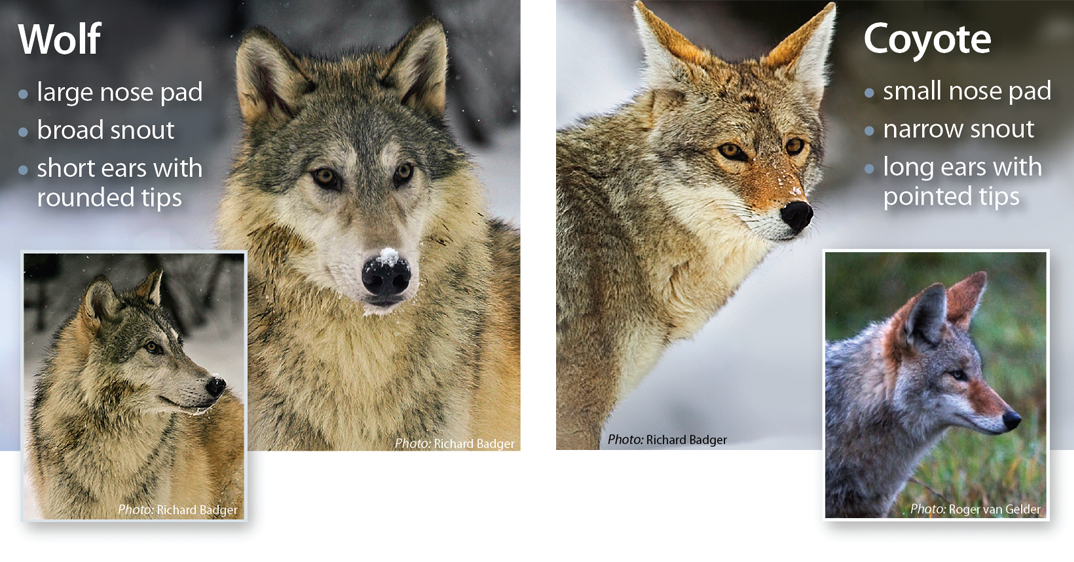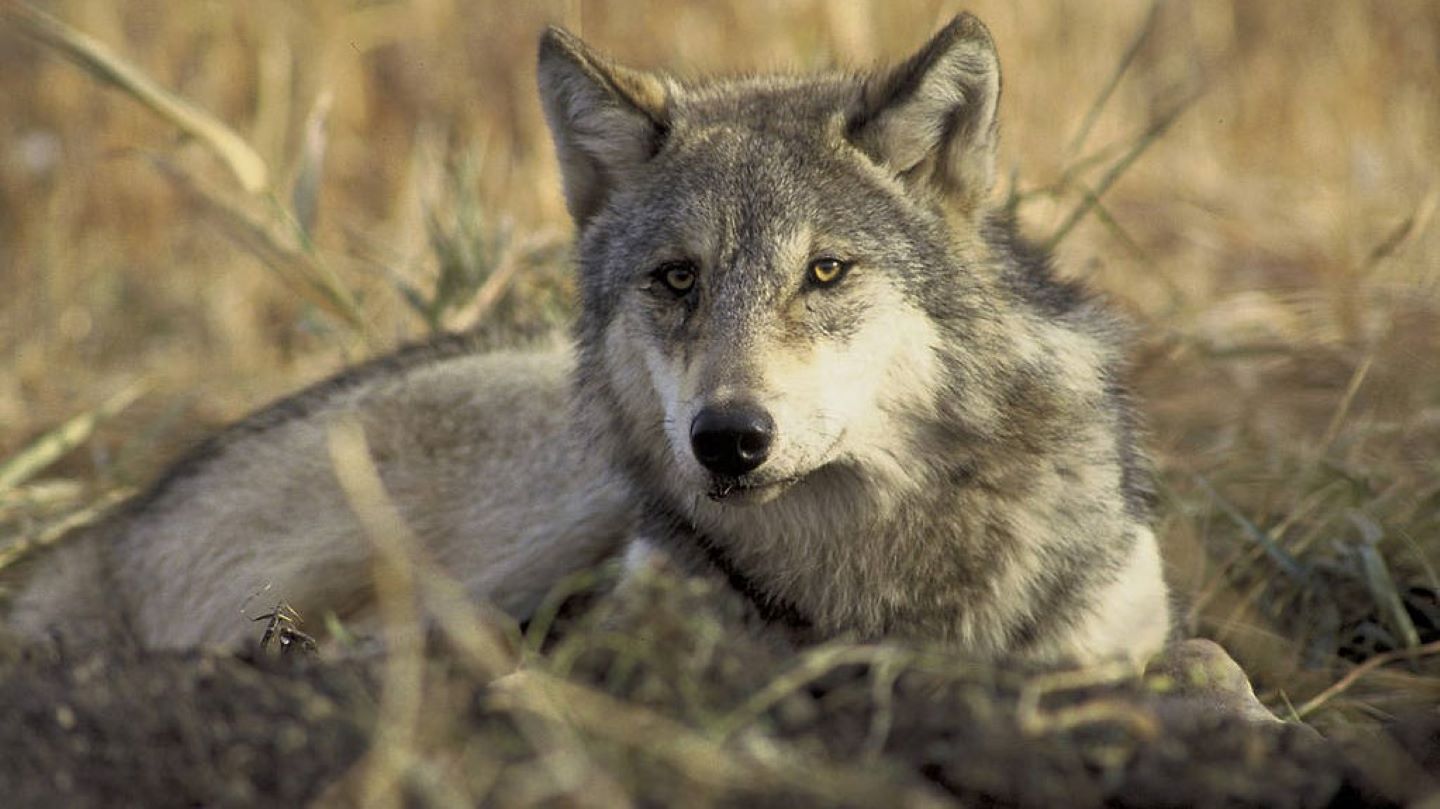
Gray Wolf Identification
Physical appearance of gray wolves
Gray wolves in the western US usually weigh between 60 to 120 pounds (27-54 kg) with adult males taking up the higher end of the spectrum. They stand 27 to 33 inches (68-84 cm) in height at the shoulders and measure 60 to 72 inches (152-183 cm) in length. A wolf’s tail is long and bushy and usually carried down or straight out, but never curled. Despite their large stature, gray wolves and other wild canids are typically very lean animals and carry very little body fat, Biologists who have handled and weighed more than 250 wolves over the last 25 years throughout Montana, Idaho, Wyoming, Washington and Oregon report that few wolves weigh more than 120 pounds (54 kg) and the largest wolf they handled was a male who weighed 144 pounds (65 kg). The largest breeds of domestic dogs are reported to weigh more than 180 pounds (91 kg).
Unlike most domestic dogs, wolves’ chests are narrow and keel-like, and their limbs and feet are just about directly under the center of their body. Their legs seem pressed into their chests with elbows that are turned inward and paws that are turned slightly outward. Their legs are moderately long compared to the legs of other canids such as coyotes and foxes. All of these adaptations lead to maximize fast, almost continuous locomotion and supports their endurance-running or cursorial hunting strategy. They can run and fast-trot all day in their pursuit of food. In general, most wild canids are cursorial hunters. In contrast, the world’s big wild cats are typically walk, or sit-and-wait predators capable of short, speedy and athletic sprints to prey, but can’t keep up with the all-day pace of a cursorial hunter like the gray wolf.
A wolf’s coat consists of a dense layer of soft, fine fur topped by long guard hairs, which give the coat its color. The color of the coat ranges from white to black shades of brown and gray. In the subarctic and boreal forest regions black and gray are common, while in the arctic, white and light-colored waives predominate. In the South, Gray phases prevail. The wolves in northwestern Montana are predominantly gray or black.
The longest hair on their coats (up to 6.7 inches (16.75 cm)) is found in the mane. Wolves can raise and lower the mane depending on their state of aggression. The mane hair, along with hair on the base of tail, is generally darker than the rest of the body. Patterns of color in facial hair accentuate expressive features. Wolves appear lankier and less robust in summer due to a much thinner coat.
Wolves Compared To Coyotes
It can be difficult to distinguish between wolves, coyotes and dogs, especially if the light is bad, the sighting is brief or the animal is far away. Because of their relatively long legs and lanky body, the first impression of a wolf is often that of a deer or calf, not of a large dog or coyote. Skulls of wolves, dogs and coyotes can usually be distinguished by measurements of teeth, orbital angle and the angle at which the rostrum and brain-case meet.
Wolf-Dog Hybrids
Distinguishing a wolf from a domestic hybrid (wolf-dog) can be difficult unless the animal has characteristics of a domestic breed such as a curly tail or floppy ears. Wolf-dog hybrids are more difficult and may be misclassified even with sophisticated measurements.
Size and features of Wolves compared to Coyotes:
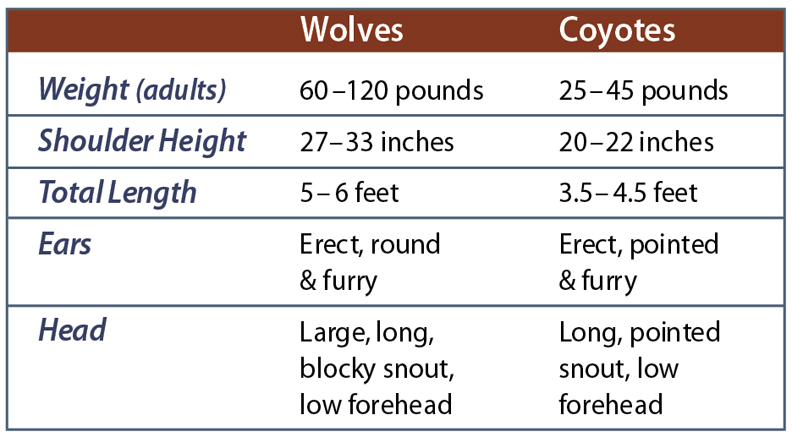
There are several characteristics that you can look for to help identify wolves in comparison to coyotes. Although there are similarities between both species, one characteristic alone doesn’t provide enough evidence to make a positive identification. Consider a combination of the traits below.
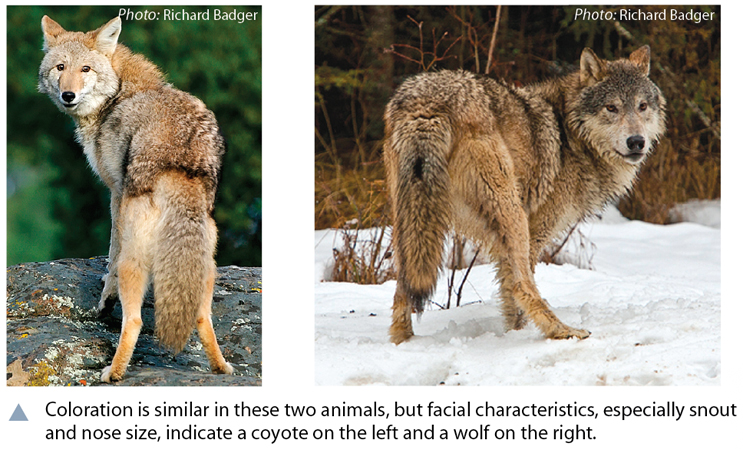
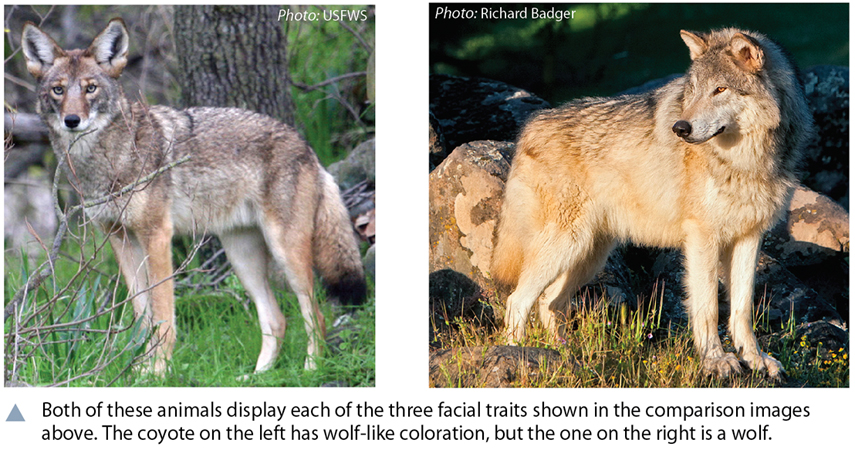
Color
Wolves come in a variety of colors, many with a grizzled gray coat or an additional reddish-orange hue, and light underside, legs and muzzle. Wolves can also be black, or even white (rare in our region) and all variations in-between. In contrast, coyotes are more consistent in their color, with typical variations of grizzled brown, gray, and reddish hues. With the exception of black or white wolves, do not rely on color to distinguish between these two species.
Snout
Wolves adapted to a life of hunting large animals, have a broader snout and larger nose pad than coyotes. Coyotes don’t handle large prey as consistently as wolves do. They have a snout that is narrow and less robust in appearance, and their nose pad is less than one inch (2.5 cm) wide.
Ears and Eyes
Wolves’ ears, roughly two inches long, are shorter relative to their head size, and more rounded at their tips when compared to coyotes’ ears, which appear longer and more pointed. The eyes of a wolf are yellow and at night their eye shine is a greenish gold.
Feet
Wolves have moderately long legs and relatively large feet which are efficient for travel on snow. Coyotes’ feet appear smaller relative to their body size.
Vocalization
Hearing a wolf howl in the wild can be a thrilling experience, especially since wolves may be heard more often than they are seen. However, differentiating between a wolf howl and the howl of a coyote or domestic dog can be difficult.
Listen for differences:
- Wolves howl in long and low tones and seldom bark, but they do practice “bark howling” when they become alarmed. Howling wolf pups can sound similar to coyotes.
- Coyote howls are generally mixed with yips, yelps, and barks that are higher pitched than those of wolves.
- The howls of large dog breeds are sometimes difficult to distinguish from the howls of wolves.

